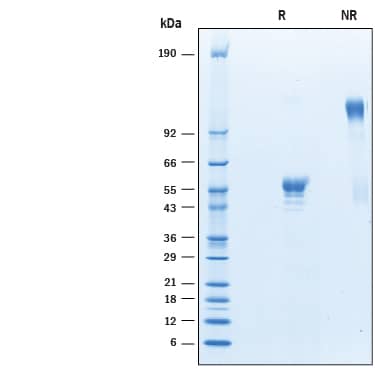Recombinant Cynomolgus Monkey CD160 Fc Chimera Protein, CF
R&D Systems, part of Bio-Techne | Catalog # 10197-CD

Key Product Details
Source
CHO
Accession #
Structure / Form
Disulfide-linked homodimer
Conjugate
Unconjugated
Applications
Bioactivity
Product Specifications
Source
Chinese Hamster Ovary cell line, CHO-derived cynomolgus monkey CD160 protein
| Cynomolgus Monkey CD160 (Ile27-Ser159) Accession # EHH50231 |
IEGRMD | Human IgG1 (Pro100-Lys330) |
| N-terminus | C-terminus |
Purity
>95%, by SDS-PAGE visualized with Silver Staining and quantitative densitometry by Coomassie® Blue Staining.
Endotoxin Level
<0.10 EU per 1 μg of the protein by the LAL method.
N-terminal Sequence Analysis
Ile27
Predicted Molecular Mass
41 kDa
SDS-PAGE
40-60 kDa, under reducing conditions
Activity
Measured by its binding ability in a functional ELISA.
When Recombinant Mouse HVEM/TNFRSF14 Fc Chimera (Catalog # 2516-HV) is immobilized at 0.5 μg/mL (100 μL/well), the concentration of Recombinant Cynomolgus Monkey CD160 Fc Chimera that produces 50% of the optimal binding response 1.5-9 ng/mL
When Recombinant Mouse HVEM/TNFRSF14 Fc Chimera (Catalog # 2516-HV) is immobilized at 0.5 μg/mL (100 μL/well), the concentration of Recombinant Cynomolgus Monkey CD160 Fc Chimera that produces 50% of the optimal binding response 1.5-9 ng/mL
Scientific Data Images for Recombinant Cynomolgus Monkey CD160 Fc Chimera Protein, CF
Recombinant Cynomolgus Monkey CD160 Fc Chimera Protein Binding Activity
When Recombinant Mouse HVEM/TNFRSF14 Fc Chimera (Catalog # 2516-HV) is immobilized at 0.5 µg/mL, Recombinant Cynomolgus Monkey CD160 Fc Chimera (Catalog # 10197-CD) binds with an ED50 of 1.5-9 ng/mL.Recombinant Cynomolgus Monkey CD160 Fc Chimera Protein SDS-PAGE
2 μg/lane of Recombinant Cynomolgus Monkey CD160 Fc Chimera (Catalog # 10197-CD) was resolved with SDS-PAGE under reducing (R) and non-reducing (NR) conditions and visualized by Coomassie® Blue staining, showing bands at 40-60 kDa and 80-120 kDa, respectively.Formulation, Preparation and Storage
10197-CD
| Formulation | Lyophilized from a 0.2 μm filtered solution in PBS with Trehalose. |
| Reconstitution | Reconstitute at 500 μg/mL in PBS. |
| Shipping | The product is shipped at ambient temperature. Upon receipt, store it immediately at the temperature recommended below. |
| Stability & Storage | Use a manual defrost freezer and avoid repeated freeze-thaw cycles.
|
Background: CD160
References
- Cai, G. & G.J. Freeman (2009) Immunol. Rev. 229:244.
- del Rio, M.L. et al. (2010) J. Leukoc. Biol. 87:223.
- Maiza, H. et al. (1993) J. Exp. Med. 178:1121.
- Anumanthan, A. et al. (1998) J. Immunol. 161:2780.
- Abecassis, S. et al. (2007) J. Invest. Dermatol. 127:1161.
- Fons, P. et al. (2006) Blood 108:2608.
- Kaye, J. et al. (2008) Nat. Immunol. 9:122.
- Giustiniani, J. et al. (2007) J. Immunol. 178:1293.
- Giustinani, J. et al. (2009) J. Immunol. 182:63.
- Barakonyi, A. et al. (2004) J. Immunol. 173:5349.
- Nikolova, M. et al. (2002) Int. Immunol. 14:445.
- Rabot, M. et al. (2006) Transpl. Immunol. 17:36.
- Cai, G. et al. (2008) Nat. Immunol. 9:176.
Alternate Names
BY55, CD160, NK1, NK28
Gene Symbol
CD160
UniProt
Additional CD160 Products
Product Documents for Recombinant Cynomolgus Monkey CD160 Fc Chimera Protein, CF
Product Specific Notices for Recombinant Cynomolgus Monkey CD160 Fc Chimera Protein, CF
For research use only
